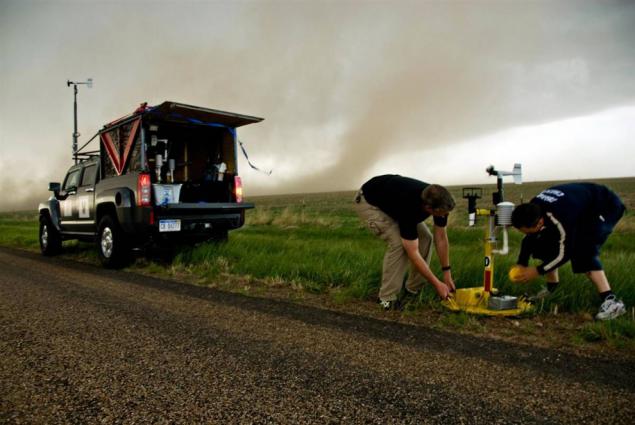Catch tornado "tail"
 Bashny.Net
Bashny.Net
A team of scientists from the project can VORTEX2 weeks to go from place to place, waiting for the formation of one of the most exciting and dangerous natural phenomena - a tornado. In June 2009, a tornado has been studied in detail by scientists using special instruments.
9 ph via Bigpicture
1. Radar RV monitors the storm in the southeast Wyoming June 5, 2009. This storm has created the strongest tornado, which was observed in the project VORTEX2. Today it is the most thoroughly studied by a tornado. (Ryan McGinnis)

2. Using a 17-meter mast can determine the coordinates of the 10 other radars in the band VORTEX2. (Herb Stein)

3. Tim Marshall and Dr. Lindsay Bennett set the device «Tornado Pod» to a strong tornado in Wyoming, June 5, 2009. These instruments measure the wind speed, temperature and relative humidity. Data logger is in an armored waterproof "black box" that can persist even if the device itself is destroyed. (Ryan McGinnis)

4. A convoy of mobile "network on wheels" is going on the road for sverhmnogoyacheechnym tornado in Wyoming. These cars have instruments that measure temperature, humidity, wind speed and pressure around the tornado, helping scientists to understand how and why the image of this natural phenomenon. (Ryan McGinnis)

5. Sealed in this picture in my already "mature" stage, the most studied in the history of the tornado moves on the horizon in the south-eastern part of Wyoming, June 5, 2009. (Rachel Humphrey)

6. Team VORTEX2 sets the device in the path of the storm, which forms a tornado. The researchers collected data from all types of storms - and those that form a tornado, and those that do not form, so that you can understand the difference. (Gino DeGrandis)

7. The most studied tornado in history is entering its final stage. (Matt Ryzdik)

8. Spetspribor to study tornadoes standing in a cornfield June 3, 2009. Although most of the days the team VORTEX2 ended peacefully - without meeting with tornadoes, scientists are not just weeks moving from place to place, trying to "catch" a tornado. (Ryan McGinnis)

9. A vehicle with a mast collects data about the approaching tornado. (Paul Robinson)

Source:
9 ph via Bigpicture
1. Radar RV monitors the storm in the southeast Wyoming June 5, 2009. This storm has created the strongest tornado, which was observed in the project VORTEX2. Today it is the most thoroughly studied by a tornado. (Ryan McGinnis)

2. Using a 17-meter mast can determine the coordinates of the 10 other radars in the band VORTEX2. (Herb Stein)

3. Tim Marshall and Dr. Lindsay Bennett set the device «Tornado Pod» to a strong tornado in Wyoming, June 5, 2009. These instruments measure the wind speed, temperature and relative humidity. Data logger is in an armored waterproof "black box" that can persist even if the device itself is destroyed. (Ryan McGinnis)

4. A convoy of mobile "network on wheels" is going on the road for sverhmnogoyacheechnym tornado in Wyoming. These cars have instruments that measure temperature, humidity, wind speed and pressure around the tornado, helping scientists to understand how and why the image of this natural phenomenon. (Ryan McGinnis)

5. Sealed in this picture in my already "mature" stage, the most studied in the history of the tornado moves on the horizon in the south-eastern part of Wyoming, June 5, 2009. (Rachel Humphrey)

6. Team VORTEX2 sets the device in the path of the storm, which forms a tornado. The researchers collected data from all types of storms - and those that form a tornado, and those that do not form, so that you can understand the difference. (Gino DeGrandis)

7. The most studied tornado in history is entering its final stage. (Matt Ryzdik)

8. Spetspribor to study tornadoes standing in a cornfield June 3, 2009. Although most of the days the team VORTEX2 ended peacefully - without meeting with tornadoes, scientists are not just weeks moving from place to place, trying to "catch" a tornado. (Ryan McGinnis)

9. A vehicle with a mast collects data about the approaching tornado. (Paul Robinson)

Source:
Tags
See also
How to build a real house out of scrap material
Overclock the brain or internal virtualization consciousness
History of one byte
Things from sci-fi movies
They no longer exist
Monsters, in which I want to believe - 2
Things of fiction that became everyday reality
Scientists have built a map of the comet Churyumov-Gerasimenko, based on high-definition images

















